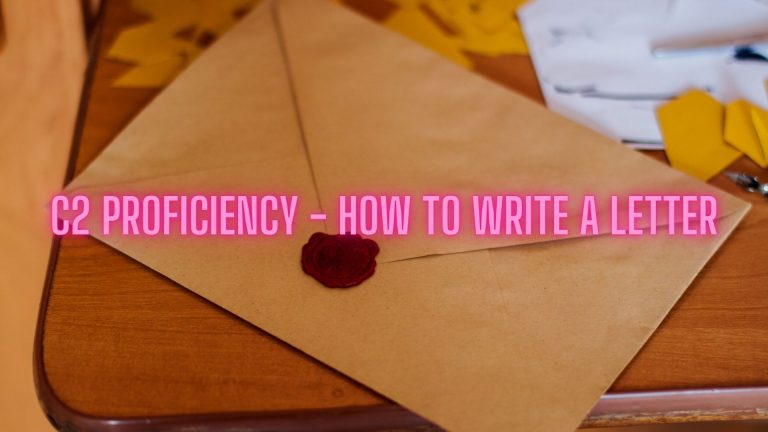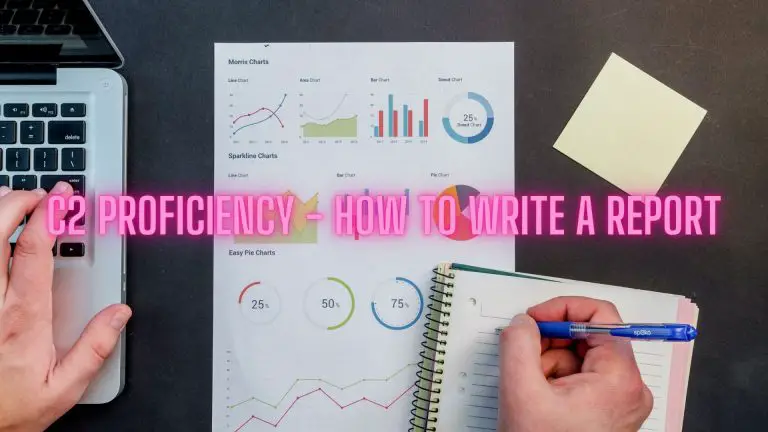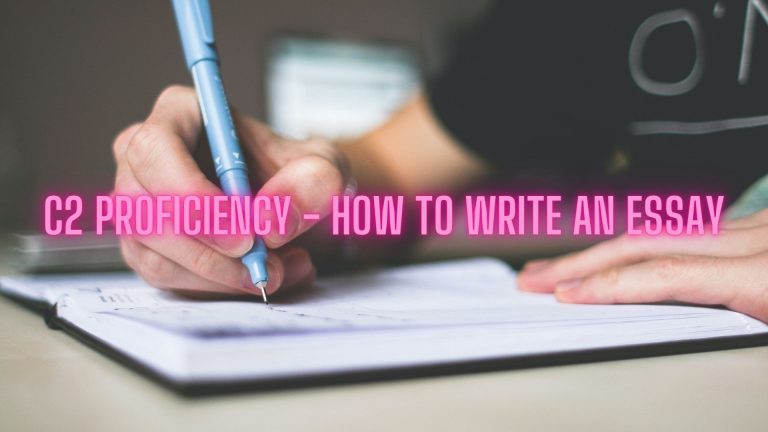Overview
- Mandatory task: no
- Word count: 280-320
- Main characteristics: descriptive, narrating, engaging, interesting
- Register: depends on the task
- Structure: Title, introduction, main paragraphs, final paragraph
Introduction
An article is written on a particular theme in a style which makes it suitable for publication in an English-language newspaper, magazine or newsletter. The question identifies the topic for the article, and the type of publication mentioned gives the candidate guidance as to the appropriate register to be used – for example, how academic or lively the article should be. The purpose of an article is to convey information; it may contain some description and/or narrative, and candidates should bear in mind the need to engage the interest of their readers.
Source: Cambridge English Assessment: C2 Proficiency Handbook for teachers
Articles are a possible type of text in Part 2 of the writing paper in Cambridge C2 Proficiency. Unlike essays, articles are not mandatory and can be chosen from a selection of tasks, such as reports, formal/informal letters or reviews.
Articles are for the creative among you
Writing an article is a great opportunity to be creative and show off your language skills because there are many great structures that you can include. Compared to an essay or report, articles are not as strict in terms of their structure and you can mold the text as you see fit. Obviously, there are certain things that you shouldn’t do, but in general, you can have some fun with your article.
Here, I’m going to show you what I think always works so you don’t have to worry about every single detail. If that sounds good to you, let’s get started.
What a typical article task looks like
In Cambridge C2 Proficiency, article tasks are typically very specific regarding the topic and the more detailed information you need to give in your text.

When you look at a task like this you should always ask yourself what the topic of your article is, what specific information you have to include and who is going to read the text so you know the appropriate style of language to use.
In this case, the topic is about alternatives to taking a plane or, to be more precise, a long-distance train or bus journey you have made. You have to talk about the advantages of such a journey and if the slower pace could be more satisfying.
Last but not least, we are writing for an international travel magazine so the register can be neutral to informal, which means that contractions like don’t or can’t are perfectly acceptable as well as some phrasal verbs here and there. However, I would try not to include any colloquial expressions because, after all, the readers are not familiar to us.
How to organise your article
This is where opinions might differ and I don’t want you to think that there is only one possible paragraph structure. At this level, you should be able to decide for yourself what works best for each individual task, but I have found over the years that the following option works most of the time:
- Title & introduction
- Main paragraph 1
- Main paragraph 2
- Final paragraph
This works for most tasks as there are usually two or three topic points you need to talk about in detail so two or three main paragraphs are a pretty safe bet.
Always plan your article
I always annoy my students with this, but making a plan before you start writing your article is an invaluable tool that saves you time and nerves once you get to the last ten or fifteen minutes of the exam. While the candidates without a plan panic and struggle to put together a coherent and cohesive piece of writing, the ones who did prepare a plan just go on writing without hesitation because they know what they want to do next.
You can simply use the paragraph structure you decided on and jot down some notes about the things you want to include in the article. Looking at our example task again, I’ve come up with the following:
- Title & introduction: The most pleasant way of long-haul travel; air travel now unpleasant (security, waiting, service); alternatives like train and bus faster, less waiting
- Main paragraph 1: describe the journey (train from Cologne to Ulm): different waypoints, rivers, scenic route
- Main paragraph 2: Why did I enjoy it? calm, quiet, landscape, in the end not much slower than going to the airport, no waiting or security, etc.
- Final paragraph: train can be very satisfying; reminder to slow down
A mere four minutes later I am ready to write an amazing article and the best thing is that I will always know what to write at any point of the process.
We have a good structure and a bunch of ideas so now we are finally ready to put pen to paper (or in this case, fingers to keyboard) and get started.

The different parts of an article
In the previous section, I showed you a good structure and created a plan that’s easy to follow so we can now create the actual article step by step.
Title & introduction
An article needs to be interesting from the beginning. Imagine reading an article in a magazine or on a website and it doesn’t engage you right from the start. What do you do? Exactly, you skip it and start looking for something more interesting.
The question is, of course, how to make it more appealing for the reader? Luckily, there are several language tools at your disposal which can make the reader want to keep going until the very last word of your article.
For example, asking the reader a question can pique their interest, especially in your introduction. It gives them a reason to continue reading because they want to find out what the answer to the question is or if the writer feels the same way.
Another great idea is to hint at something that you are going to talk about in the article without giving away all the information. Again, the reader will want to find out more and stays engaged.
Last but not least, we can always use good language, such as engaging adjectives and adverbs or punctuation like exclamation marks, in order to make the article more lively and interesting.
Let’s have a look at an example introduction for the task from earlier about a long-distance journey by bus or train:
The best journey of my life
Back in the 20th century, flying was a luxury mostly out of reach for the average Joe while nowadays it is quite possibly the cheapest and most common form of long-haul travel. However, with all the security measures and long waiting times at the airport it begs the question if buses or trains aren’t as convenient if not even more pleasant an option as planes. My journey along the river Rhine would definitely suggest that the answer is yes.
As you can see, the article has a title to begin with just as every article should. I then decided to start by establishing some kind of context. Here, I compare what air travel was like 25 or 30 years ago (“Back in the 20th century, …”) to today to then contrast it with buses and trains (“However, …”). I ask a question (“… it begs the question …”) and hint at my own experience (“My journey …”). The reader now wants to find out why it was so enjoyable for me and with that I’ve accomplished the first part of my mission – engaging the reader from the beginning.
Main paragraphs
Once the reader has been caught in the spiderweb of our intriguing introduction, we move on to the main part of the article. This is where we want to focus on the different topic points in the task – in our example the advantages of taking a bus or train as well as answering the question if travelling more slowly is more satisfying.
One stylistic feature that works very well in articles is telling a personal anecdote, which can be true or invented. The more important aspect is that, once again, it maintains a high level of attention and engagement and gives us the opportunity to include great language as well.
When I was at university I used to take the train for the 5-hour ride to visit my parents in the south of Germany. Once I was forced to take the slightly longer route along the river Rhine and I can’t even tell you how happy I am that I did it! Not only did the journey itself go really smoothly, but I also got to fully take in the stunningly beautiful scenery along the way with the river meandering past all these small towns famous for their wine and their architecture. It was a truly scenic route that kept my eyes glued to the window, something rather unusual when flying.
Apart from the breathtaking views, I have to say that I’d never arrived at a destination more relaxed than when I’d set off. Without the typical airport security checks and periods of simply sitting around and waiting I found myself actually enjoying the experience and in the end, I think I wouldn’t even have been able to reach my destination faster by plane either.
In my example paragraphs, I start by telling the story of a journey I experienced during my time at university. I use this anecdote to answer all the questions of the task and I’m able to include a lot of good language like interesting adjectives and adverbs as well as some good grammatical structures.
I also make sure that all my ideas are connected well using different cohesive devices (once; not only, but also; apart from; in the end; either).
Final paragraph
The last part of your article should bring everything together and serve as a send-off for the reader. Use it to summarise what you say and take the opportunity to address the reader directly one last time.
For me, going on this journey was a truly gratifying experience and I hope this anecdote will serve as a reminder for you to slow things down from time to time and to enjoy the process of travelling instead of being too focussed on just reaching your destination. I promise life isn’t too short.
Here, I try to use the story I tell as a lesson for myself and the reader. I summarise the journey (“a truly gratifying experience”) and say that it is sometimes better to enjoy travelling itself more than only arriving at your destination. The reader can walk away from the article with something to think about and perhaps they will book a train or bus instead of a flight the next time they want to go on holiday.
Final thoughts
Articles in Cambridge C2 Proficiency are an opportunity for you to show how well you can logically structure a piece of writing while engaging the reader consistently. I think it is a great way to balance out an essay in the exam so you have one formal and one more informal text in your portfolio.
Now, of course, it is time to put in the work and get better at it. I can help you with my writing feedback or private preparation classes that put you on the right track to success in the exam if you are interested in working with me. Until then, all the best.
Lots of love,
Teacher Phill 🙂







